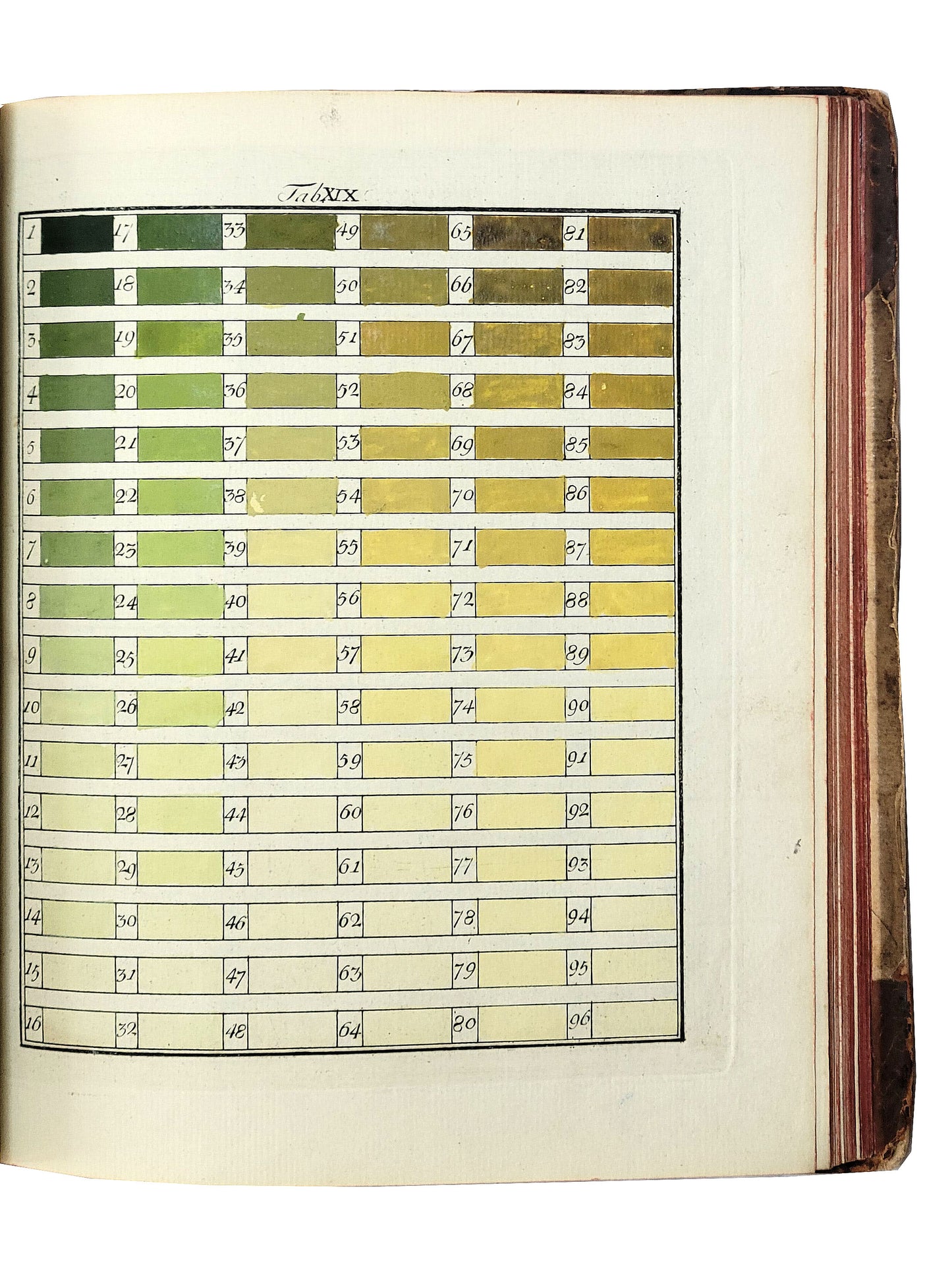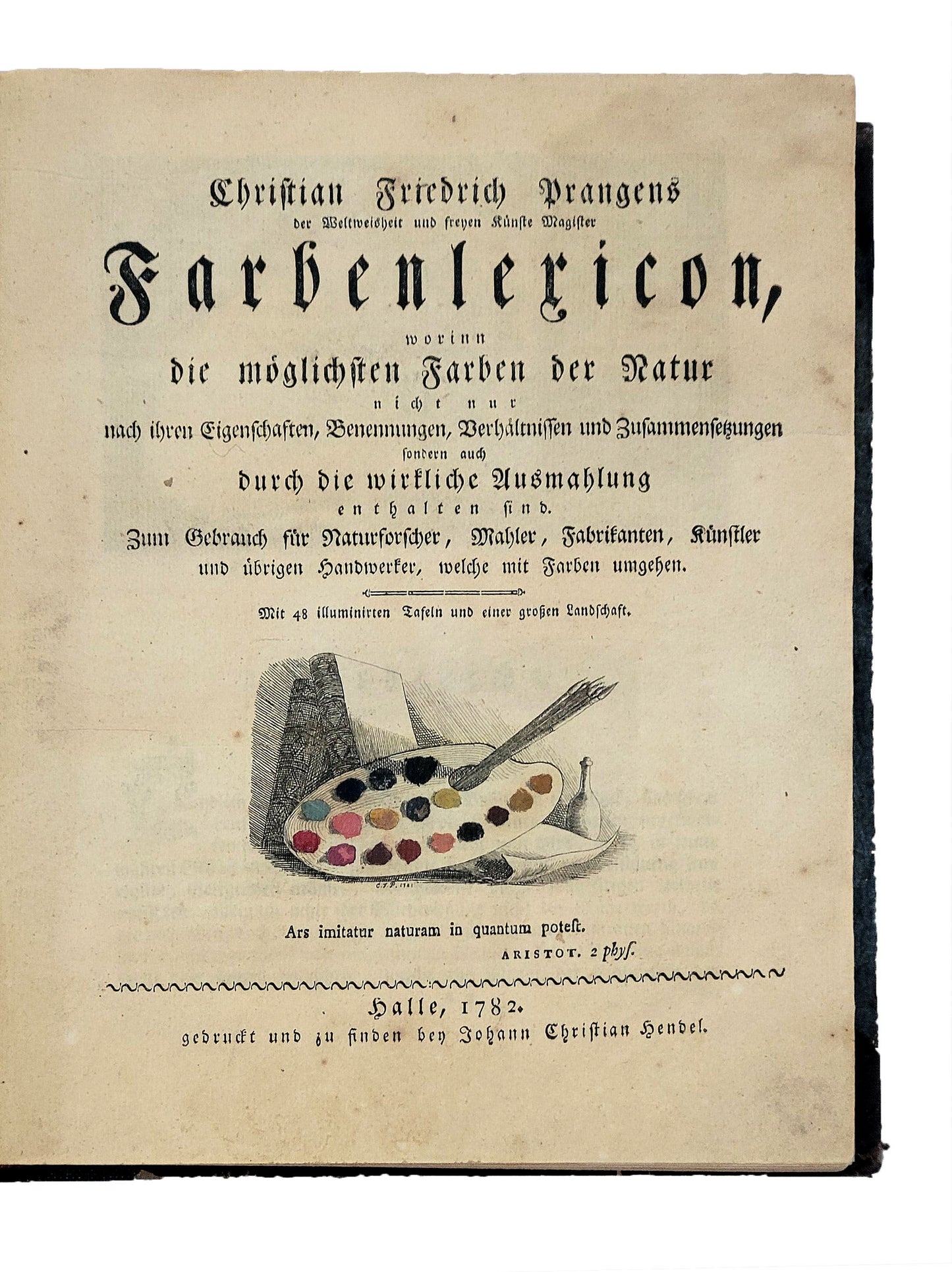Calab Rare Books
Christian Friedrich PRANGE
Christian Friedrich PRANGE
Couldn't load pickup availability
Share
Farbenlexicon, Worinn die möglichsten Farben der Natur nicht nur nach ihren Eigenschaften, Benennungen, Verhältnissen und Zusammensetzungen... Two volumes, one being text the other the plate volume. Text: xxxii, 572 pp. Illustrated with hand-coloured title vignette and one hand-coloured in-text vignette, engraved black-&-white headpiece, plus a woodcut headpiece and tailpiece, (lacking the engraved fold-out landscape). 4to., 240 x 190 mm, bound in contemporary boards, rebacked and recornered with modern cloth, new endpapers. Plate volume: Illustrated with 48 engraved plates, each with 96 hand coloured samples for a total of 4608 individual colour samples. 4to., 235 x 195 mm, bound in contemporary half calf over matching boards, spine heavily gilt. Halle: Johann Christian Hendel, 1782.
First and Only Edition, a true rarity in the field of colour theory. The dazzling atlas volume presents 4608 hand tinted samples offering one of the most complete visual and physical records of the science of colour in the eighteenth century. Written and compiled by the German polymath, Christian Friedrich Prange (1752-1836), who set out to create the most complete standard reference on colour to that point, with each sample numbered and described in the extensive text volume.
‘Each table has six columns and 16 rows, providing boxes for 96 shades which are numbered sequentially in Arabic digits down the columns. In general, as the eye travels down each column it finds progressively lighter shades of the same hue. In all, no fewer than 4608 possible colours (according to the titlepage, “die moglichsten Farben der Natur”) are shown in these charts, a figure hitherto unequalled in the description of colour within the German Tradition. A complete key to these is provided on pages 473-572 of the text volume, giving for every shade in the charts a number reference, a German name, and the composition of that colour using standard pigments, the proportions of which are stated.” (Jones, p. 223-232)
‘It is probably the first printed book on the classification of colors.’ (Moshe Ron, Bibliotheca Tinctoria, Annotated Catalog of the Sidney M. Edelstein Collection in the History of Bleaching, Dyeing, Finishing and Spot Removing, Jerusalem: Jewish National and University Library, 1991).
As is often the case with books of such grand ambition, the cost far outweighed the response, with only 25 subscribers listed. Although not among the subscribers, we know that Goethe owned a copy which is now held at the Herzogin Anna Amalia Bibliothek in Weimar. In the U.S., Worldcat only locates copies with both the text and plate volume at Yale and the University of Chicago. Although our copy lacks the folding plate of a landscape that appears in the text volume, given the works rarity, one could comfortably acquire the present example knowing another is unlikely to surface for a long time to come. In the text volume, leaf a3 of the text re-margined at the top, light even toning, minimal spotting. Atlas volume with some general wear to the binding but sound, a few samples with some oxidization, verso of two plates with light pencil doodling, in general the samples remain in a fine bright state. Overall a very good copy of a rare book.
PROVENANCE: Atlas volume with early ownership signature of F. K. Richter on the verso of the front flyleaf. Ownership stamp of Arno Wittig on the front past-down of the text volume.
Moshe Ron, Bibliotheca Tinctoria, Annotated Catalog of the Sidney M. Edelstein Collection in the History of Bleaching, Dyeing, Finishing and Spot Removing, Jerusalem: Jewish National and University Library, 1991. Jones, W.J. German Colour Terms: A study in Their Historical Evolution from Earliest Times to the Present. Amsterdam, Philadelphia: John Benjamins. 2013, pp. 223-232.
















